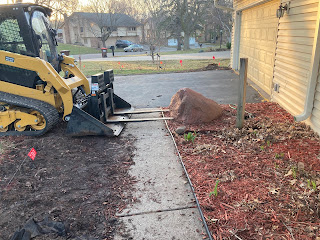Yellow & More & More
Our overgrown pet rock, sadly abandoned by its previous owners after it grew from a tiny pebble. Remember! When you take on the responsibility of caring for a pet rock, you have to love the boulder, too.
Workers swarmed our house this week, replacing the sunken front walk and dead flower bed. We'd expected them in May or June, but they got a jump on things, and let us know Monday that they could start Wednesday. This was a bit of a shock and sparked a need to move about 3 yards of dirt that we'd invested in fairly unsuccessful (if you don't count flooding our already sunken sidewalk with ice in the winter) berms. Need the dirt to build up a flat space in the back yard.
They'd hoped to finish by Friday. They worked all day Saturday, and will be coming back tomorrow (Monday). But they have been busy beavers.
Now we get the opportunity to replant our front yard with a bee friendly mix of fescues & clover.
The weather was fabulous this weekend. It's nearly overwhelming the number of things that need to be done. Oh, heck with that. It IS overwhelming. Spent a lot of time just stupefied and feeling a lot of stress about stuff that needs to happen and trying to separate it from stuff that we want to happen.
Settled for planting snow peas (some of those that I planted in March are actually coming up!) But I planted a lot more. Planted half a bed of beets. Moved raspberry canes and rescued day lilies from the the apocalypse in the front yard.
I'd started this post 10 days ago. Just catching up on it now. Needless to say, it is a busy time of year. It's been busy enough to postpone blogging in favor of doing.
So the front is in. After a week's delay because of more freezing temperatures, we finally dropped in the new bee lawn. We used a grass seed developed by the University of Minnesota's Bee Lab.
It has a ways to go before the yard is good to go again. But it will be better than it was. The new seed is advertised as:
- BEE POLLINATOR-FRIENDLY LAWN: Sustainable and resilient flowering lawn mix features Creeping Thyme, White Dutch Clover, Self-Heal and a blend of fine fescues; fosters a naturally healthy and biodiverse ecosystem
- LOW MOW MAINTENANCE: Mow biweekly to monthly to a height of 3 inches; max height if left unmowed is 12 inches; fertilizer not recommended or necessary; no need to water once established; drought tolerant
- RESEARCHED & CERTIFIED: Developed in research partnership with the University of Minnesota; 5% of all sales go to UofM Bee Lab; Blue Thumb Partners; Oregon Certified Seed
- IDEAL FOR: Residential, commercial, institutional, or municipal lawns, yards, sidewalk medians, parks, sports fields, right of ways, landscaping, and places you don’t want to mow
In fairness, it was too expensive to do the whole yard with this. So I purchased some of the constituent parts, Dutch white clover, sheep fescue & red fescue, and used that mix to fill in space as we got closer to the street.
I got beets and potatoes in the ground.
I was also able to extend the stairway closer to the top of our steep meadow, and at the same time deal with cutting down the fence posts that had made it difficult to move things (say, watering hoses) from one side of the yard to the other. This helped aesthetically, too, as our back yard looks less like a sea of treated lumber posts.
If the howling wind would just settle a little bit, things would be better.
Robins have built a nest on the security light at the front of our house. Because it is a motion detector, the light going on and off has historically deterred them. Not so this year.
Soon we'll be hardening off the tomatoes and peppers in the greenhouse. Soon, we'll have some consistently warm temperatures.
This weekend, carrots go in the ground, and we should be able to make a start levelling part of the lawn with a terrace. Right now it is a hideous pile of dirt and detritus from the front.
All very basic updates here, but that's about all the energy that's left.
Time and motion wait for no one.













Comments
Post a Comment